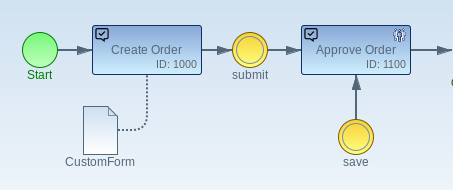The Imixs Process Manager
The digitization of business processes has become a key challenge for modern application design. Essentially, you only need two things to do this.
- a process description - which you ideally create using the BPMN 2.0 standard
- a runtime environment - which allows you to execute and persist your process instances in a secure way
The Open Source project Imixs-Workflow provides you with an open and powerful workflow management platform that combines the design and the execution of business processes in a highly scalable and easy to use environment.
With the Imixs Process Manager you can start quickly and develop and test your own business process. And of course you can customize and extend this platform and use it for development as well as for production.
How to Install
The Imixs Process Manager comes with a Docker profile which enables you to start within seconds. If you haven't already installed Docker, follow the instructions here.
Download the docker-compose.yml file...
version: "3.6"
services:
imixs-db:
image: postgres:9.6.1
environment:
POSTGRES_PASSWORD: adminadmin
POSTGRES_DB: workflow-db
volumes:
- dbdata:/var/lib/postgresql/data
imixs-app:
image: imixs/imixs-process-manager:latest
environment:
TZ: "CET"
LANG: "en_US.UTF-8"
JAVA_OPTS: "-Dnashorn.args=--no-deprecation-warning"
POSTGRES_USER: "postgres"
POSTGRES_PASSWORD: "adminadmin"
POSTGRES_CONNECTION: "jdbc:postgresql://imixs-db/workflow-db"
ports:
- "8080:8080"
- "8787:8787"
- "9990:9990"
volumes:
dbdata:... and run
$ docker-compose upAfter a few seconds the Imixs Process Manager is up and running. You can access it from your web browser at: http://localhost:8080/

You can upload your own process model and create customized forms. You can view and search running process instances.

Authentication and Authorization
Imixs-Workflow is a human-centric workflow engine which means that each actor need to authenticate against the service to interact.
The default setup of the Imixs Process Manager provides a set of predefined users which can be used for testing purpose. The test users are stored in a separate user and roles properties files. See the following list of predefined test user accounts:
| User | Role | Password |
|---|---|---|
| admin | IMIXS-WORKFLOW-Manager | adminadmin |
| alex | IMIXS-WORKFLOW-Manager | password |
| marty | IMIXS-WORKFLOW-Author | password |
| melman | IMIXS-WORKFLOW-Author | password |
| gloria | IMIXS-WORKFLOW-Author | password |
| skipper | IMIXS-WORKFLOW-Author | password |
You can add accounts or change the default account later, by updating the files "sampleapp-roles.properties" and "sampleapp-users.properties". You can also configure a different custom security realm (e.g. LDAP or Database).
You will find more information about the security concept in the Imixs-Workflow Deployent guide.
Process Design
You can define your own business process models using the Imixs-BPMN modeller tool and you can upload and execute your models directly within Imixs Process Manager. General information about how to model can be found here.
The Imixs Process Manager allows you to define custom forms for your business process without programming. By defining an XML template, you can store forms directly in a BPMN 2.0 model.

Example:
<?xml version="1.0"?>
<imixs-form>
<imixs-form-section label="Order">
<item name="_orderid" type="text" label="Order ID:" />
<item name="_orderdate" type="date" label="Order Date:" />
</imixs-form-section>
</imixs-form>You can create and change your models at runtime without interrupting your workflow instance.
Jakarta EE 10
Note: Imixs-Workflow and the Imixs-Process-Manager are based on Jakarta EE 10. The project is currently developed based on Wildfly version 27.0.0.Final.
Build
To build the artifact from sources run:
$ mvn clean installTo build the new Docker Image run:
$ mvn clean install -PdockerTo run Wildfly Server in debug mode (port 8787) you can build the Docker Image with:
$ mvn clean install -PdebugRun
To start the Imixs-Process Manger with docker-compose, run:
$ docker-compose -f docker-compose-dev.yaml upAutodeploy & Hot Deploy
We use the Manik Hot-Deploy Plugin to auto deploy the application during development. To update the deployment just run:
$ mvn installDuring development of Jakarta EE Faces you can run the autodeploy mode to update your Web Frontend autoamtically:
$ mvn manik-hotdeploy:hotdeployIn this mode the Manik-Plugin will detect updates of the Web Frontend and updates your running applicaton.
